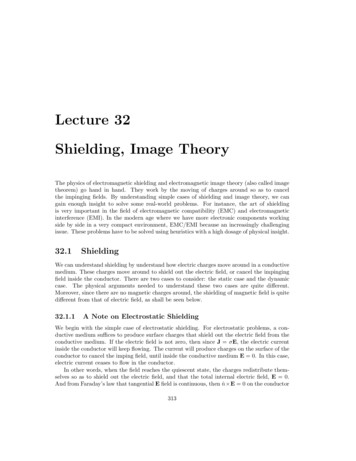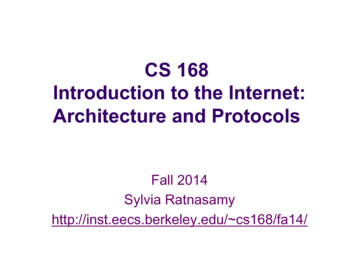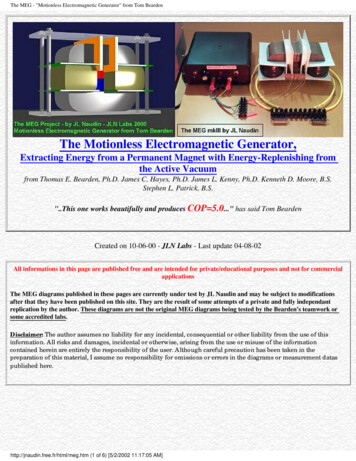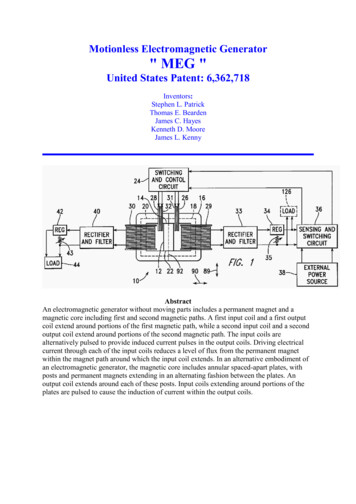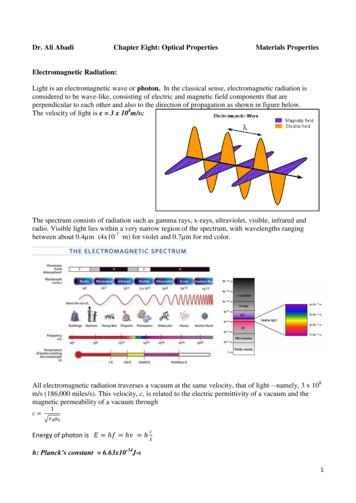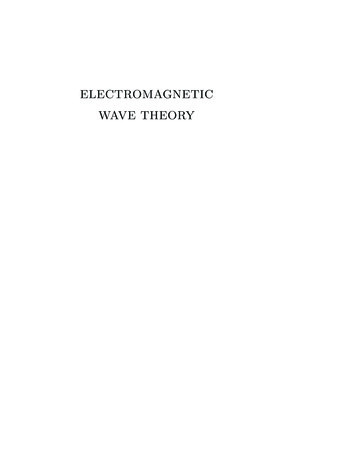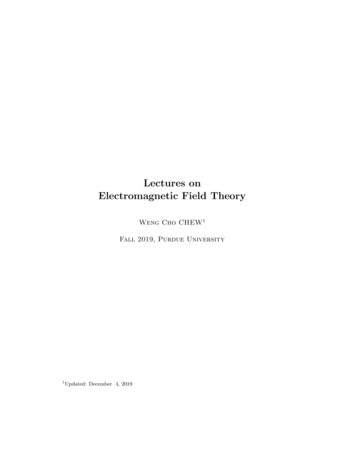
Transcription
Lectures onElectromagnetic Field TheoryWeng Cho CHEW1Fall 2019, Purdue University1Updated: December 4, 2019
ContentsPrefacexiAcknowledgementsxii1 Introduction, Maxwell’s Equations1.1 Importance of Electromagnetics . . . . . . . . . . . . .1.1.1 A Brief History of Electromagnetics . . . . . .1.2 Maxwell’s Equations in Integral Form . . . . . . . . .1.3 Static Electromagnetics . . . . . . . . . . . . . . . . .1.3.1 Coulomb’s Law (Statics) . . . . . . . . . . . . .1.3.2 Electric Field E (Statics) . . . . . . . . . . . .1.3.3 Gauss’s Law (Statics) . . . . . . . . . . . . . .1.3.4 Derivation of Gauss’s Law from Coulomb’s Law. . . . . . . . . . . . . . . . . . . . . . . . . . . . . . . . . . . .(Statics).1135556992 Maxwell’s Equations, Differential Operator Form2.1 Gauss’s Divergence Theorem . . . . . . . . . . . . .2.1.1 Gauss’s Law in Differential Operator Form .2.1.2 Physical Meaning of Divergence Operator . .2.1.3 Example . . . . . . . . . . . . . . . . . . . . .2.2 Stokes’s Theorem . . . . . . . . . . . . . . . . . . . .2.2.1 Faraday’s Law in Differential Operator Form2.2.2 Physical Meaning of Curl Operator . . . . . .2.2.3 Example . . . . . . . . . . . . . . . . . . . . .2.3 Maxwell’s Equations in Differential Operator Form .15151819192022232324.3 Constitutive Relations, Wave Equation, Electrostatics, and Static Green’sFunction3.1 Simple Constitutive Relations . . . . . . . . . . . . . . . . . . . . . . . . . . .3.2 Emergence of Wave Phenomenon, Triumph of Maxwell’s Equations . . . . .3.3 Static Electromagnetics–Revisted . . . . . . . . . . . . . . . . . . . . . . . . .3.3.1 Electrostatics . . . . . . . . . . . . . . . . . . . . . . . . . . . . . . . .3.3.2 Poisson’s Equation . . . . . . . . . . . . . . . . . . . . . . . . . . . . .3.3.3 Static Green’s Function . . . . . . . . . . . . . . . . . . . . . . . . . .3.3.4 Laplace’s Equation . . . . . . . . . . . . . . . . . . . . . . . . . . . . .i2525262929303132
iiElectromagnetic Field Theory4 Magnetostatics, Boundary Conditions, and Jump4.1 Magnetostatics . . . . . . . . . . . . . . . . . . . .4.1.1 More on Coulomb’s Gauge . . . . . . . . .4.2 Boundary Conditions–1D Poisson’s Equation . . .4.3 Boundary Conditions–Maxwell’s Equations . . . .4.3.1 Faraday’s Law . . . . . . . . . . . . . . . .4.3.2 Gauss’s Law . . . . . . . . . . . . . . . . .4.3.3 Ampere’s Law . . . . . . . . . . . . . . . .4.3.4 Gauss’s Law for Magnetic Flux . . . . . . .Conditions. . . . . . . . . . . . . . . . . . . . . . . . . . . . . . . . . . . . . . . . . . . . . . . . . . . . . . . . .5 Biot-Savart law, Conductive Media Interface,Theorem5.1 Derivation of Biot-Savart Law . . . . . . . . . . .5.2 Boundary Conditions–Conductive Media Case . .5.2.1 Electric Field Inside a Conductor . . . . .5.2.2 Magnetic Field Inside a Conductor . . . .5.3 Instantaneous Poynting’s Theorem . . . . . . . .353536373939404244Instantaneous Poynting’s.4545474749506 Time-Harmonic Fields, Complex Power6.1 Time-Harmonic Fields—Linear Systems . . . . . . . . . . . . . . . . . . . . .6.2 Fourier Transform Technique . . . . . . . . . . . . . . . . . . . . . . . . . . .6.3 Complex Power . . . . . . . . . . . . . . . . . . . . . . . . . . . . . . . . . . .555557597 More on Constitute Relations, Uniform Plane7.1 More on Constitutive Relations . . . . . . . . .7.1.1 Isotropic Frequency Dispersive Media .7.1.2 Anisotropic Media . . . . . . . . . . . .7.1.3 Bi-anisotropic Media . . . . . . . . . . .7.1.4 Inhomogeneous Media . . . . . . . . . .7.1.5 Uniaxial and Biaxial Media . . . . . . .7.1.6 Nonlinear Media . . . . . . . . . . . . .7.2 Wave Phenomenon in the Frequency Domain .7.3 Uniform Plane Waves in 3D . . . . . . . . . . .Wave. . . . . . . . . . . . . . . . . . . . . . . . . . . .636363646666666667688 Lossy Media, Lorentz Force Law, Drude-Lorentz-Sommerfeld Model8.1 Plane Waves in Lossy Conductive Media . . . . . . . . . . . . . . . . . . .8.2 Lorentz Force Law . . . . . . . . . . . . . . . . . . . . . . . . . . . . . . .8.3 Drude-Lorentz-Sommerfeld Model . . . . . . . . . . . . . . . . . . . . . .8.3.1 Frequency Dispersive Media . . . . . . . . . . . . . . . . . . . . . .8.3.2 Plasmonic Nanoparticles . . . . . . . . . . . . . . . . . . . . . . . .7373757580819 Waves in Gyrotropic Media, Polarization9.1 Gyrotropic Media . . . . . . . . . . . . . . . . . . . .9.2 Wave Polarization . . . . . . . . . . . . . . . . . . .9.2.1 Arbitrary Polarization Case and Axial Ratio9.3 Polarization and Power Flow . . . . . . . . . . . . .8383858991.
iiiContents10 Spin Angular Momentum, Complex Poynting’s Theorem, Lossless Condition, Energy Density10.1 Spin Angular Momentum and Cylindrical Vector Beam . . . . . . . . . . . .10.2 Complex Poynting’s Theorem and Lossless Conditions . . . . . . . . . . . . .10.2.1 Complex Poynting’s Theorem . . . . . . . . . . . . . . . . . . . . . . .10.2.2 Lossless Conditions . . . . . . . . . . . . . . . . . . . . . . . . . . . .10.3 Energy Density in Dispersive Media . . . . . . . . . . . . . . . . . . . . . . .11 Transmission Lines11.1 Transmission Line Theory . . . . .11.1.1 Time-Domain Analysis . . .11.1.2 Frequency-Domain Analysis11.2 Lossy Transmission Line . . . . . .939395959697.101101102105106. . . . . . . . . . . . .Ratio).10910911211311411613 Multi-Junction Transmission Lines, Duality Principle13.1 Multi-Junction Transmission Lines . . . . . . . . . . . .13.1.1 Single-Junction Transmission Lines . . . . . . . .13.1.2 Two-Junction Transmission Lines . . . . . . . . .13.1.3 Stray Capacitance and Inductance . . . . . . . .13.2 Duality Principle . . . . . . . . . . . . . . . . . . . . . .13.2.1 Unusual Swaps . . . . . . . . . . . . . . . . . . .13.2.2 Fictitious Magnetic Currents . . . . . . . . . . .12112112112212612812912914 Reflection and Transmission, Interesting Physical Phenomena14.1 Reflection and Transmission—Single Interface Case . . . . . . . . .14.1.1 TE Polarization (Perpendicular or E Polarization)1 . . . . .14.1.2 TM Polarization (Parallel or H Polarization) . . . . . . . .14.2 Interesting Physical Phenomena . . . . . . . . . . . . . . . . . . . .14.2.1 Total Internal Reflection . . . . . . . . . . . . . . . . . . . .13313313413613613712 More on Transmission Lines12.1 Terminated Transmission Lines12.1.1 Shorted Terminations .12.1.2 Open terminations . . .12.2 Smith Chart . . . . . . . . . . .12.3 VSWR (Voltage Standing Wave.15 Interesting Physical Phenomena15.1 More on Interesting Physical Phenomena, Homomorphism, Plane Waves, Transmission Lines . . . . . . . . . . . . . . . . . . . . . . . . . . . . . . . . . . . .15.1.1 Brewster Angle . . . . . . . . . . . . . . . . . . . . . . . . . . . . . . .15.1.2 Surface Plasmon Polariton . . . . . . . . . . . . . . . . . . . . . . . . .15.2 Homomorphism of Uniform Plane Waves and Transmission Lines Equations .1431431431461481 These polarizations are also variously know as the s and p polarizations, a descendent from the notationsfor acoustic waves where s and p stand for shear and pressure waves respectively.
ivElectromagnetic Field Theory15.2.1 TE or TEz Waves . . . . . . . . . . . . . . . . . . . . . . . . . . . . .15.2.2 TM or TMz Waves . . . . . . . . . . . . . . . . . . . . . . . . . . . . .16 Waves in Layered Media16.1 Waves in Layered Media . . . . . . . . . . .16.1.1 Generalized Reflection Coefficient for16.2 Phase Velocity and Group Velocity . . . . .16.2.1 Phase Velocity . . . . . . . . . . . .16.2.2 Group Velocity . . . . . . . . . . . .16.3 Wave Guidance in a Layered Media . . . . .16.3.1 Transverse Resonance Condition . .148150. . . .Media. . . . . . . . . . . . . . . .151151151154154155158158.16116116216316816918 Hollow Waveguides18.1 Hollow Waveguides . . . . . . . . . . . . . . . . . . . .18.1.1 Absence of TEM Mode in a Hollow Waveguide18.1.2 TE Case (Ez 0, Hz 6 0) . . . . . . . . . . .18.1.3 TM Case (Ez 6 0, Hz 0) . . . . . . . . . . .18.2 Rectangular Waveguides . . . . . . . . . . . . . . . . .18.2.1 TE Modes (H Mode or Hz 6 0 Mode) . . . . .17117217217317517617619 More on Hollow Waveguides19.1 Rectangular Waveguides, Contd. . . . . . . . .19.1.1 TM Modes (E Modes or Ez 6 0 Modes)19.1.2 Bouncing Wave Picture . . . . . . . . .19.1.3 Field Plots . . . . . . . . . . . . . . . .19.2 Circular Waveguides . . . . . . . . . . . . . . .19.2.1 TE Case . . . . . . . . . . . . . . . . . .19.2.2 TM Case . . . . . . . . . . . . . . . . .179179179180181182182185. . . . .Layered. . . . . . . . . . . . . . . . . . . . .17 Dielectric Waveguides17.1 Generalized Transverse Resonance Condition . . .17.2 Dielectric Waveguide . . . . . . . . . . . . . . . . .17.2.1 TE Case . . . . . . . . . . . . . . . . . . . .17.2.2 TM Case . . . . . . . . . . . . . . . . . . .17.2.3 A Note on Cut-Off of Dielectric Waveguides.20 More on Waveguides and Transmission Lines20.1 Circular Waveguides, Contd. . . . . . . . . . . . . . . . . .20.1.1 An Application of Circular Waveguide . . . . . . . .20.2 Remarks on Quasi-TEM Modes, Hybrid Modes, and Surface20.2.1 Quasi-TEM Modes . . . . . . . . . . . . . . . . . . .20.2.2 Hybrid Modes–Inhomogeneously-Filled Waveguides .20.2.3 Guidance of Modes . . . . . . . . . . . . . . . . . . .20.3 Homomorphism of Waveguides and Transmission Lines . . .20.3.1 TE Case . . . . . . . . . . . . . . . . . . . . . . . . .20.3.2 TM Case . . . . . . . . . . . . . . . . . . . . . . . . . . . . . . . . . . . . . . . . . .Plasmonic Modes. . . . . . . . . . . . . . . . . . . . . . . . . . . . . . . . . . . . . . . . . . . . . . . . . . . . . . .189189189194194195196196197199
vContents20.3.3 Mode Conversion . . . . . . . . . . . . . . . . . . . . . . . . . . . . . .21 Resonators21.1 Cavity Resonators . . . . . . . . . . . . .21.1.1 Transmission Line Model . . . . .21.1.2 Cylindrical Waveguide Resonators21.2 Some Applications of Resonators . . . . .21.2.1 Filters . . . . . . . . . . . . . . . .21.2.2 Electromagnetic Sources . . . . . .21.2.3 Frequency Sensor . . . . . . . . . .200.20320320320520820921021322 Quality Factor of Cavities, Mode Orthogonality22.1 The Quality Factor of a Cavity . . . . . . . . . . . . . . . .22.1.1 General Concepts . . . . . . . . . . . . . . . . . . . .22.1.2 Relation to the Pole Location . . . . . . . . . . . . .22.1.3 Some Formulas for Q for a Metallic Cavity . . . . .22.1.4 Example: The Q of TM110 Mode . . . . . . . . . . .22.2 Mode Orthogonality and Matrix Eigenvalue Problem . . . .22.2.1 Matrix Eigenvalue Problem (EVP) . . . . . . . . . .22.2.2 Homomorphism with the Waveguide Mode Problem22.2.3 Proof of Orthogonality of Waveguide Modes . . . . .21521521521621821922022022122223 Scalar and Vector Potentials23.1 Scalar and Vector Potentials for Time-Harmonic Fields . .23.1.1 Introduction . . . . . . . . . . . . . . . . . . . . .23.1.2 Scalar and Vector Potentials for Statics, A Review23.1.3 Scalar and Vector Potentials for Electrodynamics .23.1.4 More on Scalar and Vector Potentials . . . . . . .23.2 When is Static Electromagnetic Theory Valid? . . . . . .23.2.1 Quasi-Static Electromagnetic Theory . . . . . . . .22522522522522622822923424 Circuit Theory Revisited24.1 Circuit Theory Revisited . . . . . . . . . . . . . . . . . . . . . . . . . .24.1.1 Kirchhoff Current Law . . . . . . . . . . . . . . . . . . . . . . .24.1.2 Kirchhoff Voltage Law . . . . . . . . . . . . . . . . . . . . . . .24.1.3 Inductor . . . . . . . . . . . . . . . . . . . . . . . . . . . . . . .24.1.4 Capacitance . . . . . . . . . . . . . . . . . . . . . . . . . . . . .24.1.5 Resistor . . . . . . . . . . . . . . . . . . . . . . . . . . . . . . .24.2 Some Remarks . . . . . . . . . . . . . . . . . . . . . . . . . . . . . . .24.2.1 Energy Storage Method for Inductor and Capacitor . . . . . .24.2.2 Finding Closed-Form Formulas for Inductance and Capacitance24.3 Importance of Circuit Theory in IC Design . . . . . . . . . . . . . . .24.3.1 Decoupling Capacitors and Spiral Inductors . . . . . . . . . . .237237237238241242243243244244246249.
viElectromagnetic Field Theory25 Radiation by a Hertzian Dipole25.1 Radiation by a Hertzian Dipole . . . . . . . . . . . . .25.1.1 History . . . . . . . . . . . . . . . . . . . . . .25.1.2 Approximation by a Point Source . . . . . . . .25.1.3 Case I. Near Field, βr 1 . . . . . . . . . . .25.1.4 Case II. Far Field (Radiation Field), βr 1 .25.1.5 Radiation, Power, and Directive Gain Patterns25.1.6 Radiation Resistance . . . . . . . . . . . . . . .25125125125225425525525826 Radiation Fields, Far Fields26.1 Radiation Fields or Far-Field Approximation26.1.1 Far-Field Approximation . . . . . . .26.1.2 Locally Plane Wave Approximation .26.1.3 Directive Gain Pattern Revisited . . .26126126226326527 Array Antennas, Fresnel Zone, Rayleigh Distance27.1 Linear Array of Dipole Antennas . . . . . . . . . . .27.1.1 Far-Field Approximation . . . . . . . . . . .27.1.2 Radiation Pattern of an Array . . . . . . . .27.2 When is Far-Field Approximation Valid? . . . . . . .27.2.1 Rayleigh Distance . . . . . . . . . . . . . . .27.2.2 Near Zone, Fresnel Zone, and Far Zone . . .26926927027027327527628 Different Types of Antennas–Heuristics28.1 Types of Antennas . . . . . . . . . . . .28.1.1 Resonance Tunneling in Antenna28.1.2 Horn Antennas . . . . . . . . . .28.1.3 Quasi-Optical Antennas . . . . .28.1.4 Small Antennas . . . . . . . . . .27727727728128328629 Uniqueness Theorem29.1 Uniqueness Theorem . . . . . . . . . . . . . . .29.1.1 Isotropic Case . . . . . . . . . . . . . . .29.1.2 General Anisotropic Case . . . . . . . .29.1.3 Hind Sight . . . . . . . . . . . . . . . .29.1.4 Connection to Poles of a Linear System29.1.5 Radiation from Antenna Sources . . . .291291294294295296297. . . . . . . . . . . . . . . . . . . . . . . . . .Antennna.299299302303304305306.30 Reciprocity Theorem30.1 Reciprocity Theorem . . . . . . . . . . . . .30.1.1 Conditions for Reciprocity . . . . . .30.1.2 Application to a Two-Port Network30.1.3 Voltage Sources in Electromagnetics30.1.4 Hind Sight . . . . . . . . . . . . . .30.1.5 Transmit and Receive Patterns of an.
viiContents31 Equivalence Theorem, Huygens’ Principle31.1 Equivalence Theorem or Equivalence Principle31.1.1 Inside-Out Case . . . . . . . . . . . . .31.1.2 Outside-in Case . . . . . . . . . . . . . .31.1.3 General Case . . . . . . . . . . . . . . .31.1.4 Electric Current on a PEC . . . . . . .31.1.5 Magnetic Current on a PMC . . . . . .31.2 Huygens’ Principle and Green’s Theorem . . .31.2.1 Scalar Waves Case . . . . . . . . . . . .31.2.2 Electromagnetic Waves Case . . . . . .32 Shielding, Image Theory32.1 Shielding . . . . . . . . . . . . . . . . . . . . . . . .32.1.1 A Note on Electrostatic Shielding . . . . . . .32.1.2 Relaxation Time . . . . . . . . . . . . . . . .32.2 Image Theory . . . . . . . . . . . . . . . . . . . . . .32.2.1 Electric Charges and Electric Dipoles . . . .32.2.2 Magnetic Charges and Magnetic Dipoles . . .32.2.3 Perfect Magnetic Conductor (PMC) Surfaces32.2.4 Multiple Images . . . . . . . . . . . . . . . .32.2.5 Some Special Cases . . . . . . . . . . . . . . .33 High Frequency Solutions, Gaussian Beams33.1 High Frequency Solutions . . . . . . . . . . . . . . . . . . .33.1.1 Tangent Plane Approximations . . . . . . . . . . . .33.1.2 Fermat’s Principle . . . . . . . . . . . . . . . . . . .33.1.3 Generalized Snell’s Law . . . . . . . . . . . . . . . .33.2 Gaussian Beam . . . . . . . . . . . . . . . . . . . . . . . . .33.2.1 Derivation of the Paraxial/Parabolic Wave Equation33.2.2 Finding a Closed Form Solution . . . . . . . . . . .33.2.3 Other solutions . . . . . . . . . . . . . . . . . . . . .34 Rayleigh Scattering, Mie Scattering34.1 Rayleigh Scattering . . . . . . . . . . . . . . . . . . . . . .34.1.1 Scattering by a Small Spherical Particle . . . . . .34.1.2 Scattering Cross Section . . . . . . . . . . . . . . .34.1.3 Small Conductive Particle . . . . . . . . . . . . . .34.2 Mie Scattering . . . . . . . . . . . . . . . . . . . . . . . .34.2.1 Optical Theorem . . . . . . . . . . . . . . . . . . .34.2.2 Mie Scattering by Spherical Harmonic Expansions34.2.3 Separation of Variables in Spherical Coordinates 342344345346347347
viii35 Sommerfeld Integral, Weyl Identity35.1 Spectral Representations of Sources . . . .35.1.1 A Point Source . . . . . . . . . . .35.1.2 Riemann Sheets and Branch Cuts35.2 A Source on Top of a Layered Medium . .35.2.1 Electric Dipole Fields . . . . . . .35.2.2 Some Remarks . . . . . . . . . . .Electromagnetic Field Theory.34934934935435435535836 Computational Electromagnetics, Finite Difference Method, Yee Algorithm35936.1 Introduction to Computational Electromagnetics . . . . . . . . . . . . . . . . 35936.2 Finite-Difference Method . . . . . . . . . . . . . . . . . . . . . . . . . . . . . 36036.2.1 The Finite-Difference Approximation . . . . . . . . . . . . . . . . . . . 36036.2.2 Time Stepping or Time Marching . . . . . . . . . . . . . . . . . . . . . 36236.2.3 Stability Analysis . . . . . . . . . . . . . . . . . . . . . . . . . . . . . . 36436.2.4 Grid-Dispersion Error . . . . . . . . . . . . . . . . . . . . . . . . . . . 36636.3 The Yee Algorithm . . . . . . . . . . . . . . . . . . . . . . . . . . . . . . . . . 36836.3.1 Finite-Difference Frequency Domain Method . . . . . . . . . . . . . . 37036.4 Absorbing Boundary Conditions . . . . . . . . . . . . . . . . . . . . . . . . . 37137 Computational Electromagnetics, Numerical Methods37.1 Computational Electromagnetics and Numerical Methods . . . . .37.1.1 Examples of Differential Equations . . . . . . . . . . . . . .37.1.2 Examples of Integral Equations . . . . . . . . . . . . . . . .37.2 Subspace Projection Methods . . . . . . . . . . . . . . . . . . . . .37.2.1 Function as a Vector . . . . . . . . . . . . . . . . . . . . . .37.2.2 Operator as a Map . . . . . . . . . . . . . . . . . . . . . . .37.2.3 Approximating Operator Equations with Matrix Equations37.2.4 Mesh Generation . . . . . . . . . . . . . . . . . . . . . . . .37.3 Solving Matrix Equation by Optimization . . . . . . . . . . . . . .37.3.1 Gradient of a Functional . . . . . . . . . . . . . . . . . . . .38 Quantum Theory of Light38.1 Quantum Theory of Light . . . . . . . . . . . . .38.1.1 Historical Background . . . . . . . . . . .38.1.2 Connecting Electromagnetic Oscillation to38.2 Hamiltonian Mechanics . . . . . . . . . . . . . .38.3 Schrodinger Equation (1925) . . . . . . . . . . .38.4 Some Quantum Interpretations–A Preview . . . .38.5 Bizarre Nature of the Photon Number States . .373373373374378378379379381382383. . . . . . . . . . . . . . . . . . . . .Simple Pendulum. . . . . . . . . . . . . . . . . . . . . . . . . . . . . . . . . . . . . . . . .387387387389393395398399.40140140140440539 Quantum Coherent State of Light39.1 Quantum Coherent State of Light . . . . . . . . . . . . . . . . . . .39.1.1 Quantum Harmonic Oscillator Revisited . . . . . . . . . . .39.2 Some Words on Quantum Randomness and Quantum Observables39.3 Derivation of the Coherent States . . . . . . . . . . . . . . . . . . .
Contents39.3.1 Time Evolution of a Quantum State . . . . . . . . . . . . . . . . . . .39.4 More on the Creation and Annihilation Operator . . . . . . . . . . . . . . . .39.4.1 Connecting Quantum Pendulum to Electromagnetic Oscillator . . . .ix406407410
xElectromagnetic Field Theory
PrefaceThis set of lecture notes is from my teaching of ECE 604, Electromagnetic Field Theory, atECE, Purdue University, West Lafayette. It is intended for entry level graduate students.Because different universities have different undergraduate requirements in electromagneticfield theory, this is a course intended to “level the playing field”. From this point onward,hopefully, all students will have the fundamental background in electromagnetic field theoryneeded to take advance level courses at Purdue.In developing this course, I have drawn heavily upon knowledge of our predecessors in thisarea. Many of the textbooks and papers used, I have listed them in the reference list. Beinga practitioner in this field for over 40 years, I have seen electromagnetic theory impactingmodern technology development unabated. Despite its age, the set of Maxwell’s equationshas continued to be important, from statics to optics, from classical to quantum, and fromnanometer lengthscales to galactic lengthscales. The applications of electromagnetic technologies have also been tremendous and wide-ranging: from geophysical exploration, remotesensing, bio-sensing, electrical machinery, renewable and clean energy, biomedical engineering,optics and photonics, computer chip and computer system designs and many more. Electromagnetic field theory is not everything, but is remains an important component of moderntechnology developments.The challenge in teaching this course is on how to teach over 150 years of knowledge inone semester: Of course this is mission impossible! To do this, we use the traditional wisdomof engineering education: Distill the knowledge, make it as simple as possible, and teach thefundamental big ideas in one short semester. Because of this, you may find the flow of thelectures erratic. Some times, I feel the need to touch on certain big ideas before moving on,resulting in the choppiness of the curriculum.Also, in this course, I exploit mathematical homomorphism as much as possible to simplifythe teaching. After years of practising in this area, I find that some advanced concepts, whichmay become very complex, if one delves into the details, become simpler if mathematicalhomomorphism is exploited between the advanced concepts and simpler ones. An exampleof this is on waves in layered media. The problem is homomorphic to the transmission lineproblem: Hence, using transmission line theory, one can simplify the derivations of somecomplicated formulas.A large part of modern electromagnetic technologies is based on heuristics. This is something difficult to teach, as it relies on physical insight and experience. Modern commercialsoftware has reshaped this landscape, as the field of mathematical modeling through numerical simulations, known as computational electromagnetic (CEM), has made rapid advancesxi
xiiLectures onElectromagnetic Field Theoryin recent years. Many cut-and-try laboratory experiments, based on heuristics, have beenreplaced by cut-and-try computer experiments, which are a lot cheaper.An exciting modern development is the role of electromagnetics and Maxwell’s equationsin quantum technologies. We will connect Maxwell’s equations toward the end of this course.This is a challenge, as it has never been done before to my knowledge.Weng Cho CHEWDecember 4, 2019 Purdue UniversityAcknowledgementsI like to thank Dan Jiao for sharing her lecture notes in this course, as well as Andy Weinerfor sharing his experience in teaching this course. Also, I am thankful to Dr. Na for helpingteach part of this course.
Lecture 1Introduction, Maxwell’sEquations1.1Importance of ElectromagneticsWe will explain why electromagnetics is so important, and its impact on very many differentareas. Then we will give a brief history of electromagnetics, and how it has evolved in themodern world. Then we will go briefly over Maxwell’s equations in their full glory. But wewill begin the study of electromagnetics by focussing on static problems.The discipline of electromagnetic field theory and its pertinent technologies is also knownas electromagnetics. It has been based on Maxwell’s equations, which are the result of theseminal work of James Clerk Maxwell completed in 1865, after his presentation to the BritishRoyal Society in 1864. It has been over 150 years ago now, and this is a long time comparedto the leaps and bounds progress we have made in technological advancements. But despite,research in electromagnetics has continued unabated despite its age. The reason is thatelectromagnetics is extremely useful, and has impacted a large sector of modern technologies.To understand why electromagnetics is so useful, we have to understand a few pointsabout Maxwell’s equations. First, Maxwell’s equations are valid over a vast length scale from subatomic dimensionsto galactic dimensions. Hence, these equations are valid over a vast range of wavelengths,going from static to ultra-violet wavelengths.1 Maxwell’s equations are relativistic invariant in the parlance of special relativity [1]. Infact, Einstein was motivated with the theory of special relativity in 1905 by Maxwell’sequations [2]. These equations look the same, irrespective of what inertial referenceframe one is in. Maxwell’s equations are valid in the quantum regime, as it was demonstrated by PaulDirac in 1927 [3]. Hence, many methods of calculating the response of a medium to1 Currentlithography process is working with using ultra-violet light with a wavelength of 193 nm.1
2Electromagnetic Field Theoryclassical field can be applied in the quantum regime also. When electromagnetic theoryis combined with quantum theory, the field of quantum optics came about. Roy Glauberwon a Nobel prize in 2005 because of his work in this area [4]. Maxwell’s equations and the pertinent gauge theory has inspired Yang-Mills theory(1954) [5], which is also known as a generalized electromagnetic theory. Yang-Millstheory is motivated by differential forms in differential geometry [6]. To quote fromMisner, Thorne, and Wheeler, “Differential forms illuminate electromagnetic theory,and electromagnetic theory illuminates differential forms.” [7, 8] Maxwell’s equations are some of the most accurate physical equations that have beenvalidated by experiments. In 1985, Richard Feynman wrote that electromagnetic theoryhas been validated to one part in a billion.2 Now, it has been validated to one part ina trillion (Aoyama et al, Styer, 2012).3 As a consequence, electromagnetics has had a tremendous impact in science and technology. This is manifested in electrical engineering, optics, wireless and optical communications, computers, remote sensing, bio-medical engineering etc.Figure 1.1: The impact of electromagnetics in many technologies. The areas in blue areprevalent areas impacted by electromagnetics some 20 years ago [9], and the areas in red aremodern emerging areas impacted by electromagnetics.2 This means that if a jet is to fly from New York to Los Angeles, an error of one part in a billion meansan error of a few millmeters.3 This means an error of a hairline, if one were to fly from the earth to the moon.
Introduction, Maxwell’s Equations1.1.13A Brief History of ElectromagneticsElectricity and magnetism have been known to humans for a long time. Also, the physicalproperties of light has been known. But electricity and magnetism, now termed electromagnetics in the modern world, has been thought to be governed by different physical laws asopposed to optics. This is understandable as the physics of electricity and magnetism is quitedifferent of the physics of optics as they were known to humans.For example, lode stone was known to the ancient Greek and Chinese around 600 BCto 400 BC. Compass was used in China since 200 BC. Static electricity was reported bythe Greek as early as 400 BC. But these curios
Dec 04, 2019 · Lectures on Electromagnetic Field Theory Weng Cho CHEW

